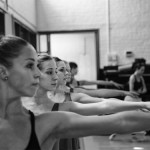Fixing the fear of standing in front: 5 tips to conquer unset classes

Don’t be a sheeple (even though they’re terribly cute). Photo by Ian Sane via Flickr
I’ll admit, there was a time when I would dread unset classes. I was so anxious about standing in front that I’d make damn sure to always aim for the middle of the barre – you know, the safe zone, always with someone in front and behind to copy.
Class after unset class, I would take my position in the safe zone and passively learn the steps to each new tendu or frappé exercise, always able to copy from someone if I lost my way. No stress, no harm done.
Until of course I was called to the front of the barre. Holy Pavlova! With the stress of remembering the steps, the timing, the sequence, and the pressure of getting it all right, my cortisol levels shot higher than Brooklyn Mack’s cabriole!
A little help from science – learning new steps minus the stress
Start applying these five tips in your next class and soon, instead of slinking into obscurity, you’ll actually ask to stand in front. Imagine that.

Photo by Dierk Schaefer via Flickr.
1) Be a control freak
Have you noticed how the smart freaks and the control freaks manage to pick up new choreography with no stress? But being ‘smart’ actually has nothing to do with it – even A-students can get caught in the don’t-put-me-in-front stress.
Psychologists have found that people who step up and assume authority over a situation (‘control freaks’) are much better at picking up new information than those who’d rather stand in the middle and let others take responsibility.
It has to do with your hippocampus, the part of the brain involved with memory formation. It functions far more effectively when we are actively, rather than passively, involved in something. This means that you’re able to pick up that new adage far more easily when you actively take up the lead and assume responsibility for learning it.
Each time you copy someone, you’re using the passive part of the brain and you’ll battle to remember the steps when you turn around and repeat it on the other side.
It’s a subtle but powerful shift in mindset that anyone can do. While in class, be a leader, never follow.
2) Choose your attitude wisely
It’s about adopting an “I’m going to do this” attitude rather than the fearful “please don’t make me do this”, or worse, the apologetic “don’t copy me, I might get it wrong” mindset.
Depending on the attitude you choose – yes, it is most definitely your choice – the brain actually works differently and the body responds accordingly.
3) Don’t set yourself up for failure
Never apologise upfront that you might make mistakes or jokingly warn people not to follow you. Those “ha ha, follow me at your peril” comments send a message to your brain that you’re already anticipating mistakes and you’ve relinquished responsibility before you’ve even started. You may be in front, but you’re not leading anymore.
4) Fake it till you make it
So maybe you’re the one who always complains and jokes about standing in front. Well, you’ll have some habits to break from now on. First, decide not to make a fuss about taking the lead. Then, each time you catch yourself saying something to undermine yourself, quickly correct it (in your head, unless you want some strange looks). Remind yourself that that was yesterday’s you, and that today’s you is going to lead like never before. After all, you are what you think.
And as for the expectations of your fellow dancers? Realise that people are far more worried about themselves than about whether you get the steps right or not.
5) Act like you’re in front, even when you’re not
Pretend like you’re the only dancer in the class and never copy, even when you’re in the middle. At first, you’ll find it rather hard to ignore the others, because you’ve actually trained yourself to watch them in your peripheral vision.
But the more you un-train yourself to copy and re-train yourself to take control, the quicker the hippocampus makes it all work for you. In fact, all it takes is one clear decision to conquer this class and you’ve already got your memory firing on all cylinders.
Category: Mind








